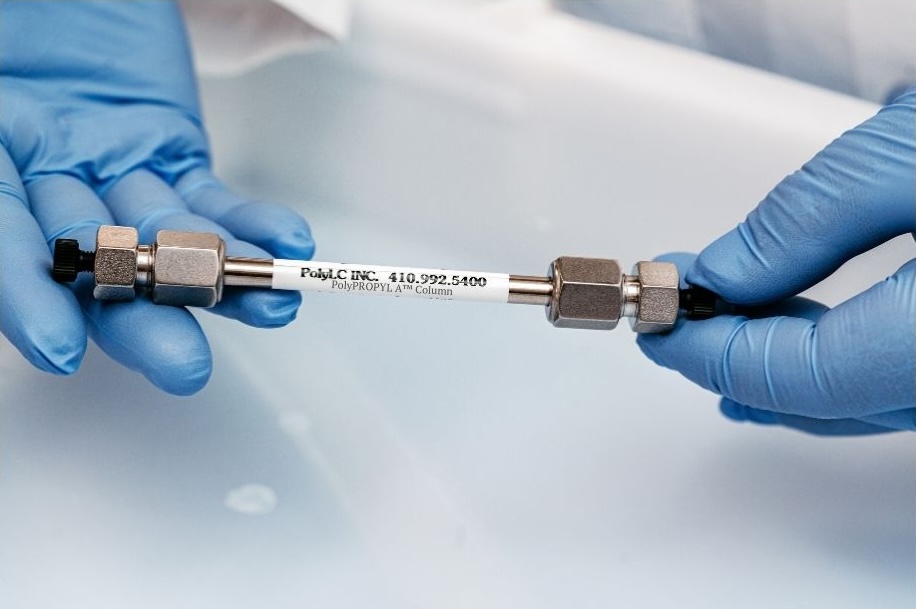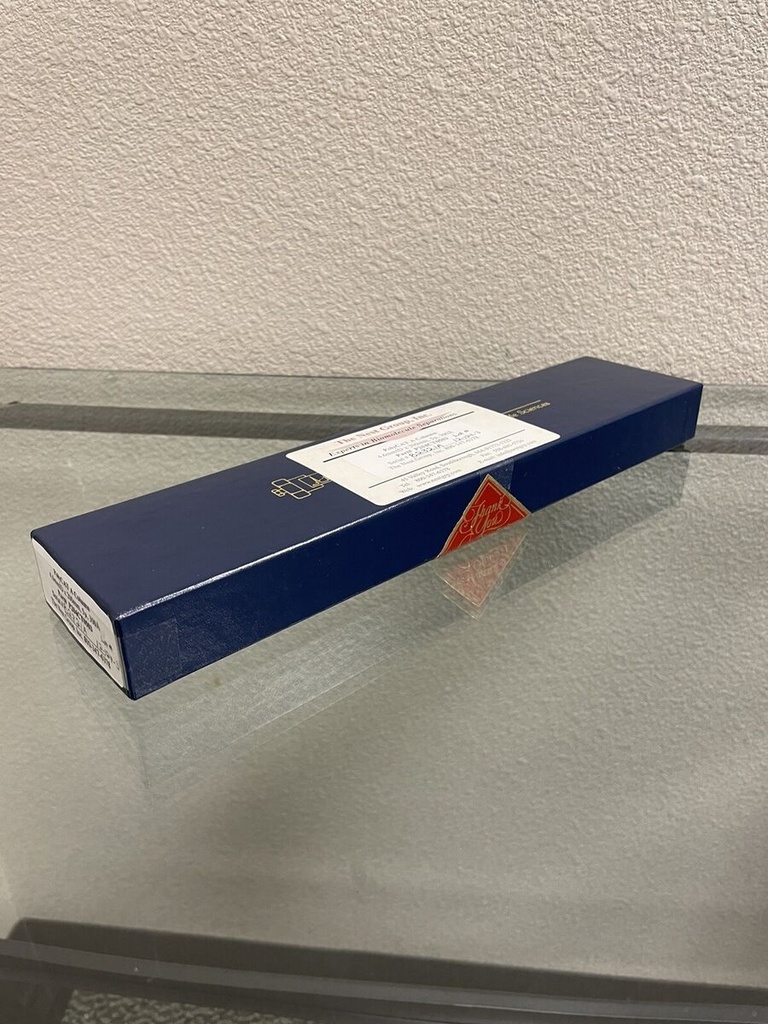Specifications:
| Application | HPLC |
| Storage Temperature | Ambient |
| Product Type | columns |
| Product Brand | PolyLC Inc. |
| Product Grade | Analytical grade |
The PolyCAT A™ LC Column is a high-performance weak cation-exchange (WCX) chromatography column designed for protein and peptide separations, including protein variants, hemoglobin analysis, monoclonal antibodies, and histones. Featuring a covalently attached poly(aspartic acid) coating on silica, PolyCAT A™ provides high recovery, sharp peak resolution, and minimal tailing, making it ideal for biopharmaceutical and clinical applications.
This 3 µm particle size column is available in various dimensions, offering high efficiency, excellent selectivity, and superior binding capacity for proteins with a pI above 6.0.
Key Features & Benefits
1. High-Resolution Weak Cation-Exchange (WCX) Chromatography
- Poly(aspartic acid)-coated silica support ensures sharp peak elution and minimal tailing.
- Excellent recovery and high binding capacity for proteins larger than 20 kDa.
- Optimized for separation of protein isoforms and post-translational modifications.
2. Specialized Applications for Protein & Hemoglobin Analysis
- Ideal for resolving protein variants such as PEGylated proteins, deamidation, and desialylation.
- Commonly used in hemoglobin variant analysis in clinical chemistry.
- Preferred for analyzing monoclonal antibodies and histones.
3. Superior Performance in Gradient Elution Methods
- Works efficiently in pH 6-7 phosphate or Bis-Tris buffers.
- pH-sensitive retention allows fine-tuned separations with adjustable ionic strengths.
- Gradient elution using unbuffered acetic acid allows protein elution in volatile solvents.
4. Broad Compatibility & Robust Column Performance
- Compatible with aqueous, organic, and volatile mobile phases.
- Suitable for protein separations using salt and/or pH gradients.
- Strong mechanical stability ensures reproducible performance over extended use.
Specifications
| Property | Details |
|---|---|
| Brand | PolyCAT A™ |
| Particle Size | 3 µm |
| Stationary Phase | Poly(aspartic acid) on silica |
| Column Type | Weak Cation-Exchange (WCX) |
| Pore Size | 300 Å, 1000 Å or 1500 Å (for proteins >20 kDa) |
| pH Range | 4.0 – 8.0 |
| Operating Temperature | Ambient (20-25°C) (Avoid high temperatures) |
| Elution Methods | Salt and pH gradient elution |
| Storage Conditions | Store in water at 4°C (long-term storage with 20% ACN to prevent microbial growth) |
| Max Loading Capacity | ~4 mg protein per injection (4.6 mm ID column) |
Column Dimensions & Ordering Information
| Column Size | Application | Catalog Number |
|---|---|---|
| 50 × 1.0 mm | Micro-scale protein analysis | 051CT03-- |
| 100 × 1.0 mm | Micro-scale protein separations | 101CT03-- |
| 150 × 1.0 mm | Peptide and protein variant analysis | 151CT03-- |
| 35 × 2.1 mm | Fast separations | 3.52CT03-- |
| 50 × 2.1 mm | Small sample analysis | 052CT03-- |
| 100 × 2.1 mm | High-resolution protein separations | 102CT03-- |
| 35 × 4.6 mm | Fast hemoglobin separations | 3.54CT03-- |
| 50 × 4.6 mm | High-resolution hemoglobin analysis | 054CT03-- |
| 100 × 4.6 mm | General protein analysis | 104CT03-- |
| 150 × 4.6 mm | Protein variant analysis | 154CT03-- |
| 200 × 4.6 mm | Monoclonal antibody (mAb) separations | 204CT03-- |
| 100 × 9.4 mm | High-throughput protein purification | 109CT03-- |
| 200 × 9.4 mm | Large-scale protein fractionation | 209CT03-- |
| 250 × 9.4 mm | Large-molecule protein separations | 259CT03-- |
| 300 × 9.4 mm | Extended protein retention | 309CT03-- |
Applications
1. Pharmaceutical & Biopharmaceutical Analysis
- Protein variant analysis (deamidation, PEGylation, glycosylation, desialylation, oxidation, etc.).
- Monoclonal antibody characterization and purity testing.
- Peptide and protein charge variant separation.
2. Clinical & Hemoglobin Variant Testing
- Analysis of hemoglobinopathies and thalassemias.
- Detection of abnormal hemoglobin variants (HbA1c, HbS, HbC, etc.).
- Screening for genetic hemoglobin disorders.
3. Proteomics & Structural Biology
- Histone analysis and post-translational modification (PTM) studies.
- Charge-based fractionation of proteins and polypeptides.
- Characterization of complex protein mixtures.
4. Biotechnological & Industrial Applications
- Protein purification and fractionation for research & development.
- Analysis of recombinant protein expression in biotech labs.
- Characterization of protein-based therapeutics.
Column Use & Maintenance
Initial Conditioning
- Flush new columns with 15 column volumes of water (30 mL for 200 × 4.6 mm columns).
- Condition with 40 mM EDTA.2Na (low flow, 20-24 hrs) to passivate metal surfaces and stabilize performance.
- Alternatively, use 0.2 M NaH₂PO₄ + 0.3 M sodium acetate for 2 hours.
Routine Use & Maintenance
- Use pH 6-7 buffers (phosphate or Bis-Tris) for optimal retention.
- Flush with high-salt buffer at the start of the day before equilibration.
- End-of-day column flushing with 15 column volumes of water is recommended.
- Avoid prolonged exposure to pH above 8 to prevent column degradation.
Storage Recommendations
- Short-Term (Overnight): Store in 100% mobile phase A.
- Medium-Term (Several days): Store in pure water at 4°C.
- Long-Term: Store in water + 20% acetonitrile (ACN) to prevent microbial growth.
The PolyCAT A™ LC Column (3 µm particle size) is a high-efficiency weak cation-exchange chromatography column, optimized for protein and peptide separations. With exceptional peak resolution, high binding capacity, and robust silica-based support, it is ideal for protein variant analysis, hemoglobin testing, monoclonal antibody characterization, and proteomics research.
- Column Dimension: 50 x 1.0 mm 100 x 1.0 mm 35 x 2.1 mm 50 x 2.1 mm 100 x 2.1 mm 100 x 4.6 mm 200 x 4.6 mm 100 x 9.4 mm 200 x 9.4 mm 150 x 1.0 mm 20 x 4.0 mm (very fast Hb) 35 x 4.6 mm (fast Hb) 50 x 4.6 mm (high-res Hb) 150 x 4.6 mm 250 x 9.4 mm 300 x 9.4 mm
- Pore Size: 300 Å 1000 Å 1500 Å




 0
0



